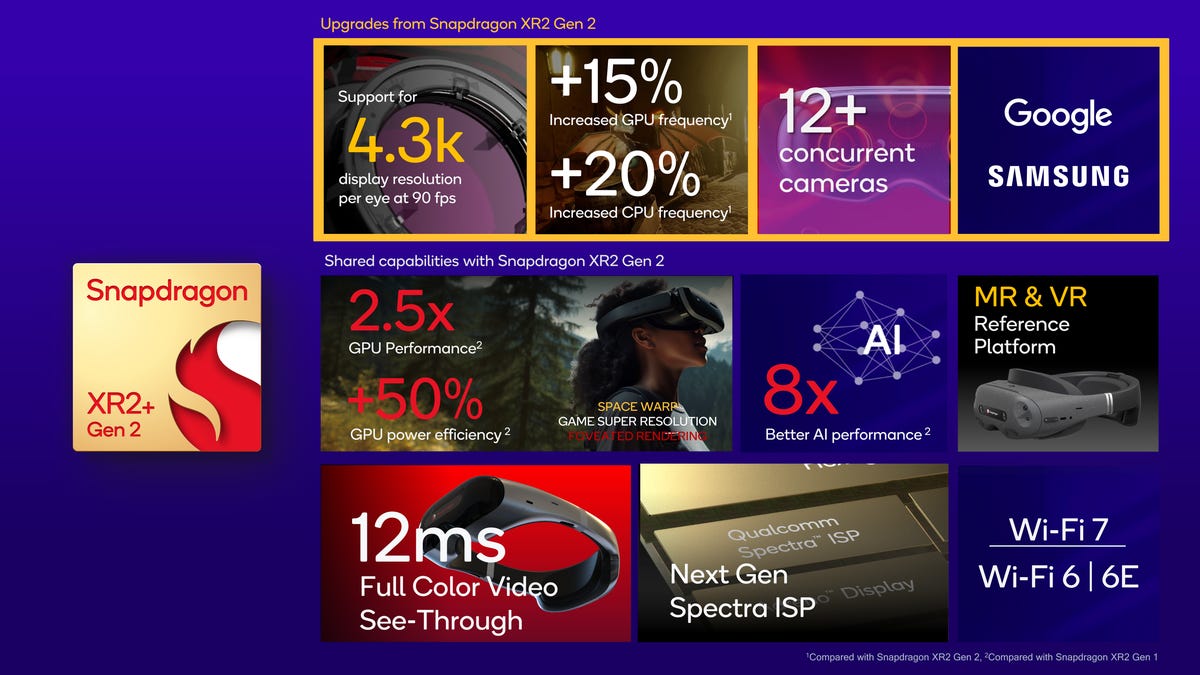Samsung and Google are expected to unveil an advanced mixed reality headset sometime in the next year that will aim to compete with Apple’s Vision Pro. We now know what processor it’ll be using: a new version of Qualcomm’s XR chips. The Snapdragon XR2 Plus Gen 2 chip, announced Thursday, will be in Samsung’s hardware, as well as a number of other upcoming headsets. Qualcomm’s details on the new chip indicate a lot about what Samsung’s headset could do, and what a wave of more expensive, pro-focused headsets could be bringing in the next year or two.
Meta’s Quest 3, which arrived last fall, was the first headset with Qualcomm’s next-gen XR2 Gen 2 chip, which boosted graphics, color passthrough camera quality, external camera support and onboard AI feature possibilities. The step-up XR2 Plus Gen 2 chip, although confusingly named, is aimed at an upcoming line of even more premium headsets that could directly compete with Apple’s $3,499 Vision Pro in features and price.
Qualcomm has confirmed some partners making upcoming devices with the new chip besides Samsung: HTC Vive, Immersed (a work software company that’s already making its own VR visor), Chinese esports company Play for Dream and an as-yet-unannounced hardware partner that’s being revealed at this year’s CES show in Las Vegas next week.
4K displays, better passthrough mixed reality
The new chip’s biggest advantages are in pushing higher-resolution displays and more simultaneous cameras and trackers, including eye tracking and full-body tracking depending on how manufacturers wanted to design their hardware. Qualcomm promises up to 4.3K pixel resolution per eye using the new chip at a 90Hz refresh rate.
The improved resolution should also mean better passthrough camera quality, according to Said Bakadir, Qualcomm’s senior director of product management in charge of VR/AR business. It will support better camera resolutions and display the images in more detail on better displays. Meta’s $500 Quest 3 has significantly better cameras than the Quest 2, making for apps that can blend camera footage of the real world with VR to create AR-like experiences that feel like they’re in your world. Apple’s upcoming $3,500 Vision Pro has better cameras and displays than the Quest 3, but headsets like Samsung’s and others could maybe begin to approach Apple’s level of mixed-reality quality using Qualcomm’s new chips.

More sensors, cameras, trackers
Expect headsets with this upgraded Qualcomm chip to also have more sensors. The XR2 Plus Gen 2 supports up to 12 cameras and sensors at once, up from eight on the XR2 Gen 2 on the Quest 3. Some of those cameras could be related to external video capture or motion tracking, or depth sensors. Others, as Qualcomm outlined, would be internal: eye and face tracking cameras much like those on the Meta Quest Pro or Apple’s Vision Pro. Meta could be another possible candidate for a headset using this chip if a Quest 3 Pro is ever released.
Other types of sensors could also be in play. Besides in-controller camera sensors much like what’s in the Quest Pro controllers (which also have their own chips), full-body tracking sensors could be in play. Or, new ways of sensing hand and body movements. Reports have already suggested that Samsung and Google might use radar-based Soli sensor technology to help with near-body gesture tracking.
Qualcomm has made its own reference device headset with partner Goertek using Tobii eye-tracking cameras to explore foveated rendering in mixed reality using this chipset. The Quest 3 doesn’t have eye tracking, but odds are that many of the headsets using this new chip will.
Connecting with other devices
Wi-Fi 7 support which could mean connecting to laptops, tablets and phones faster. Qualcomm already has split rendering technology that shares processing between headsets and other computers and has been exploring ways for phones and AR glasses to work together. It says the cross-device relationship could be even stronger on headsets with these new chips, including using phones with the headset. Bakadir says conversations with partners are being worked out to enable the infrastructure, but phones are a key part. Besides sharing rendering, devices could collaborate on AI functions, or sharing sensors. Bakadir points to one possible use for fitness, using a phone camera to track your body for a workout being done in VR or AR as the two devices link to each other.
Apple is already leaning heavily on pitching the Vision Pro as a full computer that can also connect with Macs. Samsung and Google may have a similar approach for their headset, connecting better with computers and phones and perhaps Google’s Android OS.
Shahram Izadi, vice president of AR at Google, specifically invokes Android in a statement via Qualcomm’s press release, saying “We’re excited for the Android ecosystem to take advantage of Snapdragon XR2 Plus Gen 2’s capabilities and enable new
experiences.”
Samsung and Google have been tight-lipped on their mixed reality headset plans since announcing the partnership last winter, but more information should be coming sometime this year. CNET already learned that connecting with phones is likely part of what Samsung’s device will do, and being compatible with 2D apps on Google’s Play store would give it an advantage over Meta, which still doesn’t have Google Play app support despite running an OS built on Android.
